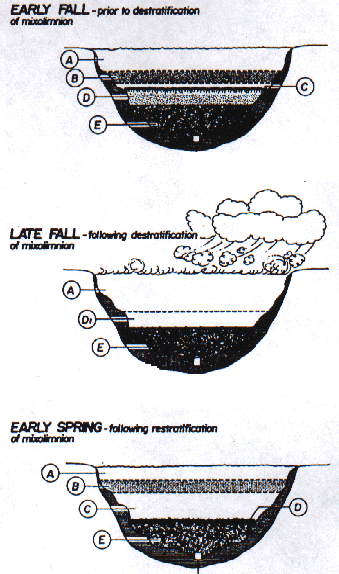During late fall the mixolimnion mixes with the oxygenated surface waters. This results in a mass mortality of all the photosynethic bacteria in zone4, therefore they settle to the bottom. In early spring the entire mixolimnion is oxygen rich with the exception of a thin layer above the chemocline.
As spring and summer pass tripton accumulates on the chemocline. The tripton decomposes and removes the dissloved oxygen from the above water, therefore increasing the thickness of the anaerobic region and permitting photobacteria to move closer to the surface.
By the end of the fall the mixolimnion is drained of its oxygen, and the anaerobic bacteria in the low mixolimnion are killed by an invasion of oxygen, and settle to the bottom. This process repeats itself annually.
|
 Schematic diagram of the major seasonal changes in the vertical distribution planktonic, anaerobic bacteria in the lake. (A) Upper mixolimnion, warm and circulating. (B) Thermocline. (C)Lower miolimnionm partially aerated zone. (D) Lowere mixolimnion, anaerobic zone. (E) Monimolimnion. From M. Dickman (1979)
Schematic diagram of the major seasonal changes in the vertical distribution planktonic, anaerobic bacteria in the lake. (A) Upper mixolimnion, warm and circulating. (B) Thermocline. (C)Lower miolimnionm partially aerated zone. (D) Lowere mixolimnion, anaerobic zone. (E) Monimolimnion. From M. Dickman (1979)
|
